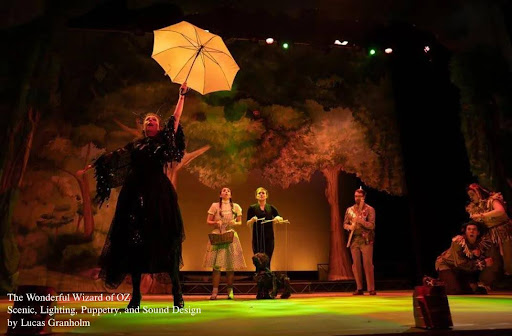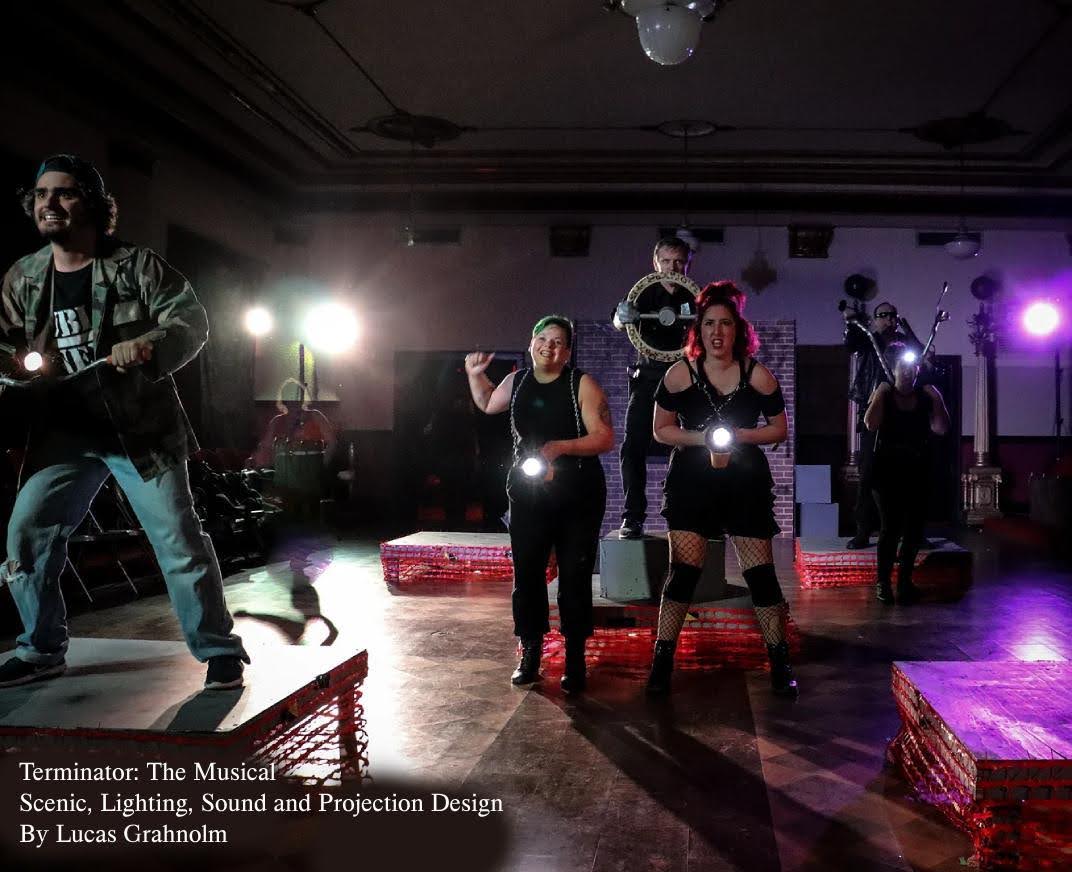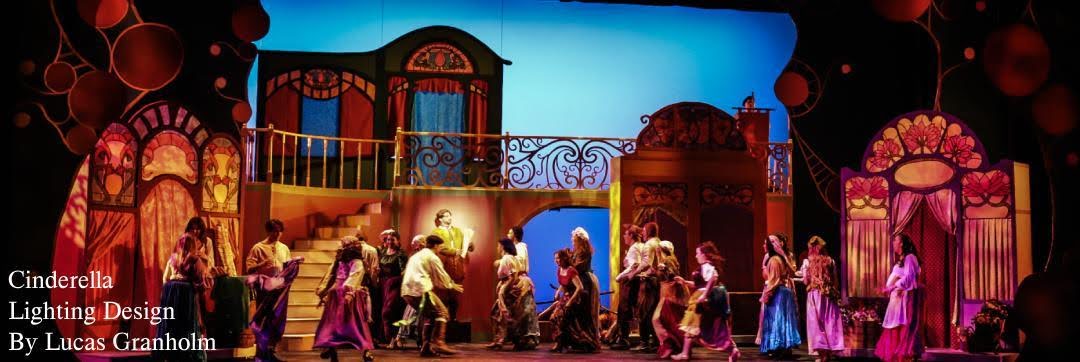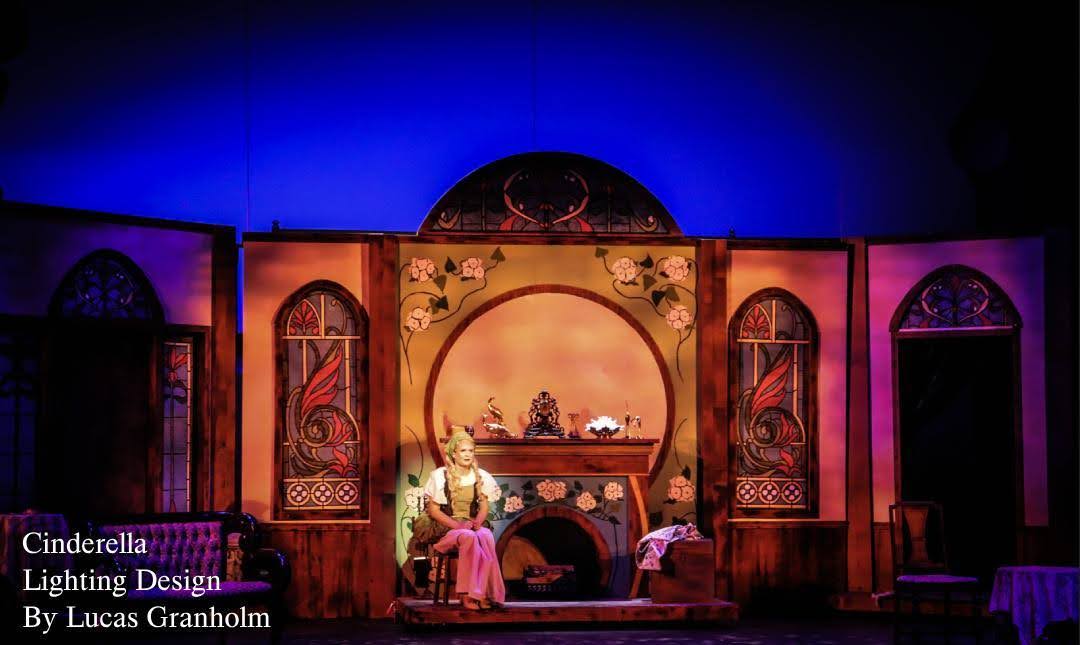Meet Our Member of the Week: Lucas Granholm
August 15, 2024
Lucas Granholm (He/Him/His) is an Associate Professor of Theatre Arts at the University of Minnesota Morris and the recipient of the Kennedy Center American College Theatre Festival/Association of Theatre in Higher Education (KCACTF/ATHE) Innovative Teaching Award. He also serves as chair of the United States Institute for Theatrical Technology Northern Boundary Section and as Program Director of the Minneapolis Green Theatre Alliance. At UMN Morris, Granholm oversees the theatre design and technology program and holds an MFA in Theatre Design and Technology from the University of South Dakota. His work has been showcased across the United States and at the Kennedy Center in Washington, D.C. Outside of teaching, Granholm works as a freelance lighting designer nationwide. Recent productions include Rodgers and Hammerstein’s Cinderella at Prairie Repertory Theatre, The Drowsy Chaperone at the Black Hills Playhouse, The Wedding Singer and Our Town at Lyric Arts, A Doll’s House at UMN Morris, and Terminator: The Musical at the Fallout Theatre.
Check out his interview and website below! All photos by Lucas Granholm
Tell us a bit about yourself! As live entertainment technicians, we always talk about our work. But who are you, outside of your work in live entertainment?
I am originally from Minneapolis, Minnesota, and I am very proud to be a resident of the state of Minnesota. I currently work at the University of Minnesota Morris as an Associate Professor of Theatre Arts and live in Morris with my wife Emily and our dog Rocky. Outside of theatre work, I love to garden, camp in our teardrop camper, and explore state parks whenever I get the chance!
What sparked your interest in lighting design? How did you get where you are today?
I started off as an actor and pursued that passion into my college years. However, I began to realize how much more excited I became during the production process, especially once we started adding lighting and other technical elements. Particularly in lighting, I could see how powerful a medium it is, and how it can control the audience’s focus and their perception of a story.
I got to where I am today with the help and support of many artists and mentors. I did not get here by myself and have been fortunate to know some amazing people who keep me motivated. I think back on the crews that helped me hang lights, run the board, or simply volunteered their time to assist with a set. Theatre requires people to devote their time to help create, and it is important to recognize those individuals as you start. The theatre industry is a community, and it is crucial for people in these communities to support and empower one another to keep going.
Be the person that others want to be around and collaborate with, and always remember that you are continually learning. Your theatre education does not stop just because you finished school!
As the program director of the Minneapolis Green Theatre Alliance, what can you tell us about that group? How do you support green theatre practices, and what can we do to help?
The Minneapolis Green Theatre Alliance is a resource for theatre makers, designers, and doers to share and celebrate ideas for "greening" our industry. We are a chapter of the Broadway Green Alliance. While based in Minneapolis, we also serve the greater Minnesota arts community. My colleague Sadie Ward and I have been working to start this movement in our state and have carried out several productions that incorporate sustainability into our designs, along with hosting a variety of webinars to inform our colleagues. Check out our website here!
Many of my designs incorporating sustainable practices have been created at the University of Minnesota Morris. These productions are not only easier on the environment but also engage our community and provide a new perspective on the work. Some of my favorite “green” productions have been A Midsummer Night's Dream, Alice @ Wonderland, and The Wonderful Wizard of Oz. These productions centered around using only reclaimed materials for the set, costumes, and props.
My best piece of advice for those looking to “green” their productions is to start with small, incremental changes in how you approach your builds and what you do after the production has closed. Making choices such as designing around stock sizes, allowing other theatres to repurpose your set pieces, or involving your community in donating clothing to avoid fast fashion can make a significant impact. Once you start, these changes will begin to snowball into bigger and bigger improvements.


Do you have a favorite project you’d like to tell us about? Or an onstage “wow” moment that you helped conceptualize?
This is a tough one to answer because it is a two-way tie!
First, let me tell you about Terminator: The Musical. For this production, I served as the Scenic, Lighting, Sound, and Projection Designer. This was the second iteration of this show written and directed by my good friend Breanna Bietz. This production was particularly unique as it was staged in an old Masonic temple in downtown Austin, TX. Doing a show—especially a musical—in a found space presents a variety of challenges that need to be addressed, such as lack of power, limited space, and the need to set up and strike after each weekend, to name a few. However, working in a found space fosters innovation and new ideas. This production demonstrates that if you get enough people involved who believe in the project, you can accomplish remarkable tasks, and the joy of the production team is palpable to the audience. I highly recommend checking out the cast album on Spotify!
Check out the original cast album
Visit the Terminator the Musical Instagram


Secondly, let me tell you about a recent production of Rodgers and Hammerstein’s Cinderella at the Prairie Repertory Theatre in Brookings, SD. I worked closely with Scenic Designer Jacee Casarella and Costume Designer Emma Arends Montes to create this large show! As you can see, the design for this production is dripping with color, and the three of us worked closely together alongside director Billy Wilburn to ensure our color palettes did not clash. However, what excites me most about this production is the growth that occurred for the students involved. For many of them, it was the largest show of their careers thus far, and it was thrilling to see them rise to the occasion! The best part about doing summer theatre is seeing learning happening in real time!


Tell us about the Northern Boundary Section of USITT! What do you do in your role as Chair, and how do you support USITT Members in your area?
As Chair, I work closely with my colleagues to help promote our organization, assist up-and-coming theatre makers in networking within our region, and promote opportunities for everyone regardless of experience or background. Regional sections are a team effort! I am nothing without my dedicated colleagues who have helped keep this chapter going!
Our in-person conference will be held on October 5th, 2024, at Macalester College in St. Paul, MN. Check out our website for more information about this great conference. All are welcome!

If you could change one thing about working in the live entertainment industry, what would it be and why?
There are a lot of things I think need to change in our industry and a lot of theatre makers are making substantial changes to how we view and do our work. What I am about to argue are conversations I have heard across higher education and the professional realm.
What I would like to change in our industry is the way we approach equitable work in our field. I often tell students that “theatre is a team sport” and that “theatre is a monument to compromise.” This means that one person should not shoulder all the production needs. This is coming from someone who often wears multiple design hats. Many of us have worked long, overnight summer stock changeovers in our careers. For years, this was viewed as the standard for summer theatre. We do this work because we love it and believe in it, but at what cost to our mental and physical health? I think there needs to be a change in workflow and expectations when designing a show. Theatre companies need to produce within the scope of their workforce. Sure, everyone wants a huge, impressive set—myself included—but I don’t want to be burnt out midway through my career. A small design can be just as powerful to the audience!
Furthermore, I don’t want student designers and technicians to avoid the industry altogether because of the extreme hours we work. Of course, there will always be gigs that require long hours up to curtain, but what I am arguing is that producing theatres should examine their workforce and make equitable choices to allow us all to have time to sleep, see our dogs, and perhaps visit family every so often.
As the recipient of the KCACTF/ATHE Innovative Teaching Award in 2022, what does being an arts educator mean to you? How do you encourage students to dive into the world of theatre and design?
Teaching students how to create and implement theatrical designs is a process that requires them to trust their instructor’s guidance and their own creative instincts. Because of this, I firmly believe that the students and their ideas come first. In the design studio, students should be challenged in an environment free from negative criticism to foster greater creative growth. Students' creativity should be nurtured throughout the process and not judged solely on the end product. Student designers should feel that their ideas and work have merit beyond the classroom and extend into various aspects of their careers as artists. I believe students must develop a strong, disciplined eye and learn to view their work objectively by asking questions such as, “What am I trying to say?” and “What else is needed to finish?” This, in turn, helps students become objective and disciplined designers. I focus on three hallmarks: Concept—viewing one’s work through the eyes of the playwright/director; Artistry—thinking creatively and objectively to solve the design problem at hand; and Working Knowledge—working within the skill sets given to a young designer and applying them appropriately.
Encouraging students to enter the field can sometimes be challenging in today’s world. The COVID-19 pandemic has definitely impacted emerging theatre makers for a variety of reasons. However, as I teach at a liberal arts institution, I cannot help but think about how theatre encompasses elements from various fields of study. I encourage students to find what interests them in that mix, discover what drives them to create, and follow that passion. Theatre means different things to different people. Find out what theatre means to you and pursue it!
As a lighting designer, what’s your favorite instrument to work with? Do you have a favorite gel color?
I think my favorite fixture is the Source 4 PARnel. I love the punchy quality of light it produces, and its ability to spot and flood makes it a versatile choice for any type of job. I can use this fixture for subtle elements in a play, and then turn around and apply it to a rock-and-roll busking rig. I've since switched all my PARnels to Source 4WRD LEDs, and I still love using them whenever I can!
I've worked almost exclusively with Rosco gels throughout my entire career, and now I feel somewhat loyal to them for my color choices. My favorite color is a tie between R3202 and R99. I love how R3202 can highlight an actor and cut through a lot of “visual noise” on stage. R99 helps create a warm sepia tone that I still haven't been able to replicate with an LED fixture. I find myself always sneaking both of these colors into my designs, regardless of the concept. Finally, I'd be remiss if I didn't give a shout-out to R51, my tried-and-true color for front light. It has such a dynamic color shift with intensities, making it a versatile front-wash color!
And if anyone from ETC or Rosco is reading this, I will gladly accept any swag!
USITT offers numerous resources and opportunities for professional development. Can you share how being a member has benefited your career and artistic growth?
For me, the most beneficial aspect of USITT and USITTNBS is the ability to network and form creative partnerships with other theatre makers, both in my region and nationally. The theatre world is like a giant small town, and it's always good to know your neighbors!
Are you working on any projects that you’re excited about right now?
I am currently working on a production of Macbeth at Augustana University in Sioux Falls, South Dakota. For this production, I am serving as the Lighting and Puppet Designer. This project excites me because we are approaching it in an extremely collaborative manner. Everyone has an equal seat at the table, whether they are a student or a professional